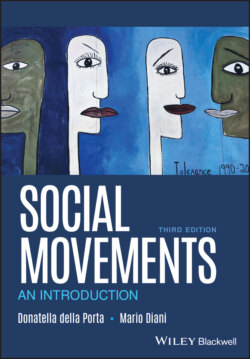Читать книгу Social Movements - Donatella della Porta - Страница 14
1.2.1 The Concept of Social Movement
ОглавлениеIn a number of pieces, Mario Diani (1992, 1995, 2013; Diani and Bison 2004) has portrayed social movements as a distinct social process, characterized by the fact that actors engaged in collective action:
hold conflictual orientations to clearly identified opponents.
connect through dense, informal networks connect them.
share a distinct collective identity.
We can look at these actions in more detail:
Conflictual collective action. Social movement actors are engaged in political and/or cultural conflicts, meant to promote or oppose social change. By conflict we mean an oppositional relationship between actors who seek control of the same stake – be it political, economic, or cultural power – and in the process make negative claims on each other – i.e., demands which, if realized, would damage the interests of the other actors (Tilly 1978; Touraine 1981, p. 80–84). Accordingly, addressing collective problems, producing public goods, or expressing support to some moral values or principles does not automatically correspond to social movement action; the latter requires the identification of targets for collective efforts, specifically articulated in social or political terms. For example, collective action challenging austerity policies in countries like Greece (Kotronaki 2013; Seferiades 2013; Diani and Kousis 2014) is conflictual to the extent that organizations like the European Commission or the International Monetary Fund are blamed not because of their officials’ misconduct or specific policy mistakes, but as representatives of distinct coalitions of interests. When collective action focuses exclusively on the behavior and/or the legitimacy of specific individuals, or blames problems on the humankind as a whole, on natural disasters or divine will, then it is difficult to speak of social movement processes (Melucci 1996, Part I).
Dense informal networks. Dense informal networks differentiate social movement processes from the innumerable instances in which collective action takes place and is coordinated mostly within the boundaries of specific organizations. A social movement process is in place to the extent that both individual and organized actors, while keeping their autonomy and independence, engage in sustained exchanges of resources in pursue of common goals. The coordination of specific initiatives, the regulation of individual actors’ conduct, and the definition of strategies all depend on permanent negotiations between the individuals and the organizations involved in collective action. No single organized actor, no matter how powerful, can claim to represent a movement as a whole. It follows that more opportunities arise for highly committed and/or skilled individuals to play an independent role in the political process, than would be the case when action is concentrated within formal organizations.
Collective identity. Social movements are not merely the sum of protest events on certain issues, or even of specific campaigns. To the contrary, a social movement process is in place only when collective identities develop, which go beyond specific campaigns and initiatives. Collective identity is strongly associated with recognition and the creation of connectedness (Pizzorno 1996; Tilly 2005). It brings with it a sense of common purpose and shared commitment to a cause, which enables single activists and/or organizations to regard themselves as inextricably linked to other actors, not necessarily identical but surely compatible, in a broader collective mobilization (Touraine 1981). For example, research on environmentalism suggested that animal rights activism were more distinctive and less identified with environmentalism in Britain than in Italy: as a result, it made much more sense to regard the two as involved in the same movement process in the latter than in the former (Rootes 2003). Likewise, not all networks between people holding similar beliefs and orientations necessarily reflect social movement processes: for example, the international Zapatista support network was not regarded by all analysts as a social movement because of the lack of a focused identity and the resulting bonds, even though resources of solidarity certainly circulated through it (Olesen 2004)). Even people who participated in major events like those that ultimately led to the demise of president Mubarak in Egypt in 2011 did not necessarily share long‐term identities beyond the common goal of toppling the dictator (Sowers and Toensing 2012; Diani and Moffatt 2016).
Collective identity building also entails actors establishing connections between different occurrences, private and public, located at different points in time and space, which are relevant to their experience, and weaving them in broader, encompassing narratives (Melucci 1996; Tilly 2005). As a result, organizational and individual actors involved in collective action no longer merely pursue specific goals, but come to regard themselves as elements of much larger and encompassing processes of change – or resistance to change. For example, in 2011, participants in events as distant as the Indignados square occupations in Spain and the anti‐government protests in Tunisia or Egypt might have felt to be linked together through processes of identity building based upon the shared call for greater democracy and supranational communication. Within social movements, membership criteria are extremely unstable and ultimately dependent on mutual recognition between actors; the activity of boundary definition – i.e., of defining who is and who is not part of the network – indeed plays a central role in the emergence and shaping of collective action (Melucci 1996, ch.3).
Looking at different combinations of these three elements enables us to contrast social movements to other collective action processes. Here we provide a few examples; however, we have to keep in mind that no empirical episode of collective action – those that we conventionally define as environmental movements, solidarity movements, disabled movements, or the like – fully corresponds to any pure type. To the contrary, we can normally detect more than one process within any empirical instance of collective action. The exploration of how such processes interact with each other represents a fundamental step of social movement analysis.
